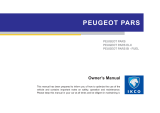Page is loading ...

1
02/07 ID# M830021
© COPYRIGHT 2007 by SPALDING
READ AND UNDERSTAND
OPERATOR'S MANUAL
BEFORE USING THIS UNIT.
FAILURE TO FOLLOW
OPERATING
INSTRUCTIONS COULD
RESULT IN INJURY OR
DAMAGE TO PROPERTY.
WARNING!
Write Model Number
From Box Here:
MP3 SPEAKER SET
OWNER’S Manual
This manual, accompanied by sales
receipt, should be saved and kept on
hand as a convenient reference, as it
contains important information about
your model.
Adult Assembly Required.
Customer Service Center
• N53 W24700 South Corporate Circle • Sussex, WI 53089
U.S.A.
Placement:
Attach bracket to pole with screws provided.
Attach the mounting bracket to the pole. The bracket is attached
using the #12 x 1 self-drilling sheet-metal screws. The holes can be
drilled with the screws themselves using a variable speed drill and a
phillips bit. If that is not available the holes can be pre-drilled with the
included drill bit.
Toll-Free Customer Service Number for U.S: 1-800-558-5234,
For Canada: 1-800-284-8339,
For Europe: 00 800 555 85234 (Sweden: 009 555 85234),
For Australia: 1-800-632 792
Internet Address: www.huffysports.com www.spalding.com
SIDE VIEW FRONT VIEW
REQUIRED TOOLS AND
MATERIALS:
• 1 Capable Adult
• Safety Glasses
• Phillips-Head Screwdriver
• Portable Drill with
Torque Adjustment
• 5/16 or 8mm Socket
Open the battery compartments located on the back of the unit.
Insert 6 AA batteries (3 in each compartment).
Power Button
Power Light

2
ID# M830021 02/07
Insert your MP3 player
into the speaker set by
lifting the latch, swinging
the door open and placing
it inside the protected
compartment.
Plug the wire into the
headphone jack of your
MP3 player.
Turn volume on the MP3
player to a reasonable
volume so not to damage
speakers.
Press the power button on
the speaker set so that the
light illuminates
Press play on your MP3
player. Then, close the
door.
Slide MP3 speaker set onto pole bracket.
WARNING! Always power the speaker set “off” when not in use.
WARNING! For your protection do not leave the speaker set out in the weather conditions
when not in use.
Safety precautions during handling of batteries.
When used correctly, batteries provide a safe and dependable source of power. However, if
they are misused or abused, leakage or - in extreme cases - explosion and/or fire can result.
WARNING! - Battery Leakage
Leakage of battery acid can cause personal injury as well as damage to your MP3 speaker set.
If battery leakage occurs, thoroughly wash the affected skin and clothes. Keep battery acid
away from your eyes and mouth. Leaking batteries may make popping sounds.
Always follow warning and instructions.
Always follow battery warning and equipment instructions carefully. Always use the
recommended battery.
Check the contact of both equipment and batteries for cleanliness. If necessary, clean
with a damp cloth and then dry.
Always insert batteries correctly with regard to polarity (+ and -) marked on the battery
and the equipment.
Batteries which are incorrectly inserted can overheat quickly. This can result in venting,
leakage and/or explosion.
Immediately remove from the equipment and dispose of exhausted batteries.
When discharged batteries are kept in the equipment for a long time, leakage can occur,
causing damage to the appliance.
Replace all batteries at the same time with new batteries of same system and
manufacture.
When batteries of different kinds are used together, or new and old ones are used together,
some batteries can be overdischarged due to a difference of voltage or capacity. This can
result in venting and/or explosion.
Remove batteries from equipment if it is not to be used for an extended period of time.
Do not short-circuit batteries.
When the positive (+) and negative (-) terminals of a battery are in electrical contact with each
other, the battery becomes short circuited. For example, loose batteries in a pocket with keys
or coins, can be short circuited. This can result in venting and leakage.
Do not heat batteries.
When a battery is heated it can result in leakage and explosion.
Do not deform batteries.
Batteries shouldn’t be crushed, punctured or otherwise damaged. This can result in venting,
leakage and/or explosion.
Do not take batteries apart.
When a battery is taken apart, contact with the components can be harmful.
Do not directly solder batteries.
When a battery is directly soldered, it can be damaged by heat. This can cause internal short
circuiting resulting in leakage, venting and possibly explosion.
Do not dispose of batteries in fire.
When batteries are disposed of in fire, the heat build-up can cause an explosion.
Do not charge batteries.
Attempting to charge a non-rechargeable battery can cause internal gas and/or heat generation
resulting in venting, explosion and/or possibly fire.
Do not mix unpacked batteries.
When unpacked batteries are mixed together, they can easily short circuit each other,
particularly button-type batteries. In some cases, it is very dangerous since batteries can heat
up and cause an explosion.
Keep batteries out of the reach of children.
Do not allow children access to batteries. Keep all, especially small batteries that could be
swallowed, out of their reach. In case a cell or battery has been swallowed, the person should
seek medical assistance promptly.
/
